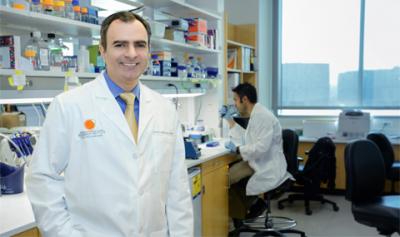Researchers identify key mechanism in metabolic pathway that fuels cancers

This is Ralph DeBerardinis, M.D., Ph.D. Credit: UT Southwestern
Published in Cell Reports, andfollowing up on Dr. DeBerardinis' landmark finding in 2011, this most recent discovery identifies the triggering mechanism that plays a key role in causing a series of energy-generating chemical reactions known as the Krebs cycle to run in reverse.
“With this finding, we have learned there are particular enzymes that work together to enable the reverse pathway to function, much like the tiny gears that turn in opposite directions to power a mechanical clock,” said Dr. DeBerardinis, director of CRI's Genetic and Metabolic Disease Program and associate professor in the Department of Pediatrics and the Eugene McDermott Center for Human Growth and Development at UT Southwestern Medical Center.
The identification of the mechanism could provide a future target for drugs that would attack tumors relying upon the reverse pathway for sustenance and growth. Tumors of this type, often found in the brain, lungs and kidneys, tend to be difficult for oncologists to treat because cells using the atypical pathway seem to resist existing treatments like chemotherapy.
“Prior to this discovery, we didn't have enough information about how to tap into the reverse metabolic pathway without disrupting the pathways that were operating in the typical, forward manner,” said Dr. DeBerardinis, senior author of the study. “We now believe there is a specific enzyme critical to the reverse pathway that can be deleted without impairing normal function. If we can eliminate that enzyme, we may be able to starve tumors of their supply of building blocks for growth.”
Dr. Andrew Mullen, a former graduate student in the DeBerardinis lab who is now a postdoctoral fellow at the Whitehead Institute for Biomedical Research, was first author of the paper. Other CRI and UT Southwestern researchers involved in the study were Dr. Zeping Hu, Xiaolei Shi, Dr. Lei Jiang,
Dr. Lindsey Boroughs, Dr. Zoltan Kovacs and Dr. Dinesh Rakheja. Scientists from Northwestern University and the National Cancer Institute also participated.
The project was supported by grants from the National Institutes of Health and the Welch Foundation, and donors to the Children's Medical Center Foundation.
About CRI
Children's Medical Center Research Institute at UT Southwestern (CRI) is a joint venture established in 2011 to build upon the comprehensive clinical expertise of Children's Medical Center of Dallas and the internationally recognized scientific excellence of UT Southwestern Medical Center. CRI's mission is to perform transformative biomedical research to better understand the biological basis of disease, seeking breakthroughs that can change scientific fields and yield new strategies for treating disease. Located in Dallas, Texas, CRI is creating interdisciplinary groups of exceptional scientists and physicians to pursue research at the interface of regenerative medicine, cancer biology and metabolism, fields that hold uncommon potential for advancing science and medicine. More information about CRI is available on its website: cri.utsw.edu
Media Contact
All latest news from the category: Life Sciences and Chemistry
Articles and reports from the Life Sciences and chemistry area deal with applied and basic research into modern biology, chemistry and human medicine.
Valuable information can be found on a range of life sciences fields including bacteriology, biochemistry, bionics, bioinformatics, biophysics, biotechnology, genetics, geobotany, human biology, marine biology, microbiology, molecular biology, cellular biology, zoology, bioinorganic chemistry, microchemistry and environmental chemistry.
Newest articles

Superradiant atoms could push the boundaries of how precisely time can be measured
Superradiant atoms can help us measure time more precisely than ever. In a new study, researchers from the University of Copenhagen present a new method for measuring the time interval,…

Ion thermoelectric conversion devices for near room temperature
The electrode sheet of the thermoelectric device consists of ionic hydrogel, which is sandwiched between the electrodes to form, and the Prussian blue on the electrode undergoes a redox reaction…

Zap Energy achieves 37-million-degree temperatures in a compact device
New publication reports record electron temperatures for a small-scale, sheared-flow-stabilized Z-pinch fusion device. In the nine decades since humans first produced fusion reactions, only a few fusion technologies have demonstrated…





















